LaDIA Fellows Program
About | Past Fellows | How to Apply
2016 Fellows
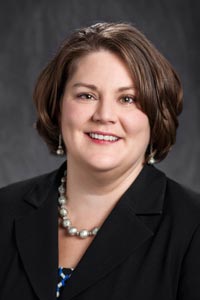 Carol J. Friedland
Carol J. Friedland
Louisiana State University
Bert S. Turner Department of Construction Management
An aspect of my research that I’m excited about:
I am excited about improving the quality of life for coastal residents by increasing our understanding of the performance of built infrastructure subjected to wind and flood hazards and developing cost-effective, sustainable mitigation strategies that increase coastal resilience.
Why my research is important:
My overall research vision is to understand, assess, and model the behavior of buildings and other infrastructure subjected to combined hurricane wind, storm surge, and wave forces and to develop building-specific, cost-effective, sustainable mitigation design recommendations to reduce hurricane damage by bridging the gaps between the engineering/construction communities and decision makers (e.g., building/homeowners, policy makers). My research interests are divided into five major categories: 1) definition and validation of the combined wind, storm surge, and wave hazard environment; 2) damage and loss modeling; 3) remote sensing damage assessment; 4) field validation (ground-truthing) of damage models and remote sensing assessment; and 5) community resilience, sustainability and economic viability. This research is important because our ability to maintain communities in coastal areas depends on the built environment to shelter and provide employment and services for members of these communities.
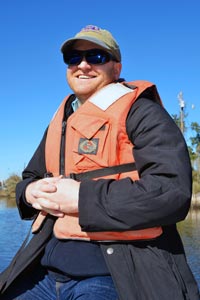 Achim Herrmann
Achim Herrmann
Louisiana State University,
Department of Geology & Geophysics
An aspect of my research that I’m excited about:
My research aims at understanding the effects of multiple stressors on water quality and ecosystem health, with an emphasis on oysters.
Why my research is important:
Louisiana has extensive private and public oyster beds and is the largest production of eastern oysters (Crassostrea virginica) in the United States. It is therefore critical to assess the impacts of ocean acidification, deoxygenation and other stressors on the coastal habitats. My research in the Gulf of Mexico focuses on field based observations. I try to understand chemical changes in the water using cutting edge geochemical approaches to better assess the impact of multiple stressors on coastal water quality and oysters.
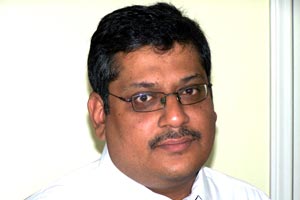 Tamjidul Hoque
Tamjidul Hoque
University of New Orleans,
Department of Computer Science
An aspect of my research that I’m excited about:
We are developing machine learning based robust vessel-management-system to monitor and predict the behavior of the fishing vessels from real-time data on the movement of vessel obtained from integrated spatio-temporal information systems as well as currently modeling algal gene regulation to access environmental impact in biofuel production.
Why my research is important:
My current research focuses on disorder protein prediction to measure and quantify cellular activities effectively. I am also working on vessel management system by predict the behavior of the fishing vessels from real-time data. Further, I am modeling to access and study the relationship among different algal species to understand their evolution for adapting the changing environment as well as production of biofuel such as lipid and H2 in Louisiana’s environment. This is important because, the project can restore the environment, establishing missing links by completing the renewable biofuel production cycle: carbon sequestration, converting CO2 to O2 in greater amount and use CO2 and sunlight to produce biofuel. The industry generated CO2 can be passed into the water for algae to consume. The algae can treat the municipal waste-water from the sewerage as well as from the Mississippi river by consuming the nutrients and in return we can have cleaner water. The research can enhance biofuel production and help boost Louisiana’s economy. In brief, my research is useful in numerical modelling and machine leaning applications towards Environmental Informatics for management and forecasting.
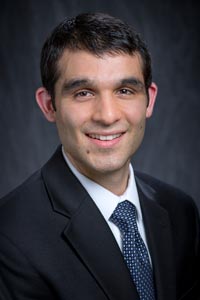 Navid H. Jafari
Navid H. Jafari
Louisiana State University,
Department of Civil and Environmental Engineering
An aspect of my research that I’m excited about:
The coast provides many benefits to Louisiana, from natural resources to recreation. These benefits are diminishing because of wetland loss. I am excited that my research plays an integral role in understanding and predicting how we can implement coastal protection and restoration projects to sustain our wetlands into the future.
Why my research is important:
Louisiana’s coast is facing sea level rise, subsidence, coastal erosion, and increased risk of flooding from hurricanes. I study how we can improve protection and restoration projects in Louisiana’s Coastal Master Plan so that they are resilient to future challenges. In particular, we have limited funds to implement the projects proposed in the Master Plan, thus we need to balance cost and performance criteria. For example, if we have a better understanding of the compression of soils, we do not have to overdesign marsh creation projects, thereby substantially reducing costs while maintaining the required performance.
I use field tests to measure the strength of various wetland soils and vegetation. I also study how waves erode the edges of marsh. My team and I are combining both sets of information to create an innovative mathematical model that will predict marsh erosion due to storm generated waves. Predicting marsh edge erosion is important because it is a leading contributor to wetland loss, and because it is challenging to measure accurately. Different Louisiana marshes have different elevations, vegetation, and soil types. All of these factors influence how well marshes resist erosion, and it is these factors that our model considers. Our model is the first of its kind to account for both the driving forces of waves and the capacity of marshes to withstand erosion.
A model that better predicts future marsh edge erosion will allow us to identify where the most vulnerable wetlands will be in the future. Our model will also forecast the impact of restoration projects in Louisiana’s Coastal Master Plan, allowing us to design more efficient shoreline restoration and protection measures. By providing stakeholders the data needed to make informed decisions, my work will help build more resilient marshes against future sea level rise, subsidence, and tropical storms.
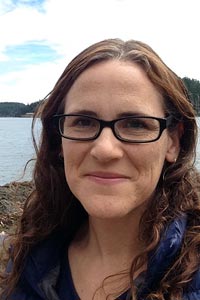 Morgan Kelly
Morgan Kelly
Louisiana State University,
Department of Biology
An aspect of my research that I’m excited about:
Mapping adaptive variation among stocks of Louisiana oysters will help managers choose stocks for supportive breeding programs
Why my research is important:
For any fishery, natural genetic variation is of critical importance, affecting aquaculture success, the outcome of restoration, recovery from overharvest, and the capacity to respond to environmental change. Louisiana’s eastern oyster fishery is the nation’s largest, and oysters in the Gulf of Mexico also provide critical ecosystem services, stabilizing shorelines, providing nursery and foraging habitat for other species, and improving water quality. There is evidence for considerable population subdivision of oyster populations throughout the Gulf of Mexico, however, there are no comprehensive data on genetic variation among or within Louisiana oyster stocks, limiting managers’ abilities to choose stocks for aquaculture, or to predict the ways that environmental change might differentially impact stocks with varying environmental histories. In my research, I integrate fieldwork, experimental evolution, and next-generation sequencing to explore the physiological and genetic underpinnings of adaptation to environmental stress in marine invertebrates. In my current, Louisiana Sea Grant-funded research, I am using these tools to quantify genetic variation for salinity tolerance among stocks of Louisiana oysters, with the goal of informing and supporting future restoration efforts.
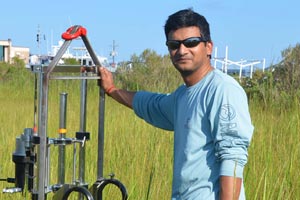 Kanchan Maiti
Kanchan Maiti
Louisiana State University,
Department of Oceanography & Coastal Sciences
An aspect of my research that I’m excited about:
I am excited about our newly developed autonomous sampling platform that will allow in situ measurement of various sediment biogeochemical processes at water depths up to 6000 meters.
Why my research is important:
My research is aimed towards understanding the fate and transport of different forms of carbon in coastal and deep ocean. Photosynthetic fixation of CO2 in surface ocean into different forms of organic carbon effectively removes CO2 from atmosphere. In absence of this process, our atmospheric CO2 concentration would have been ~50% higher than it is at present times. Understanding this process known as the “biological pump” is extremely important in determining the role of ocean in controlling atmospheric CO2 and how that might change in future. However a large fraction of this organic carbon fixed by phytoplankton in the ocean gets released back into the water column and atmosphere as CO2 and other inorganic forms of carbon via respiration and microbial decomposition. Thus the availability of organic carbon can directly and indirectly impact various biogeochemical processes in the ocean like formation of hypoxia, increase in ocean acidification, release of various redox sensitive elements and contaminants from the sediments. My research group at LSU seeks to provide answers to some of these fundamental questions related to ocean carbon biogeochemistry and environmental quality through field based observations, natural isotope tracers and laboratory microcosm experiments.
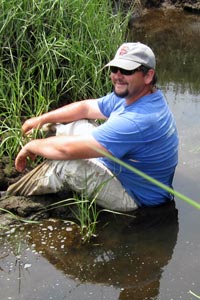 James Nelson
James Nelson
University of Louisiana at Lafayette,
Department of Biology
An aspect of my research that I’m excited about:
I am excited about a new project that will quantify the contribution of restored marshes to shrimp production.
Why my research is important:
People rely on coastal ecosystems for food, recreation, and even their livelihoods. I work to understand how these complex systems operate and how the many services they provide change in response to disturbance, exploitation, and restoration. My lab’s current focus is on how the food webs that support fisheries resources, such as shrimp, redfish, and red snapper, will respond to the many coastal restoration efforts underway in Louisiana and the Gulf Coast. To do my research I employ a variety of experimental approaches and chemical tracers to understand about how animals move around coastal habitats and what their primary food resources are. The overall goal of my lab’s research is to help resource managers make scientifically informed decisions to maximize the health of our coastal ecosystems to ensure their future health.
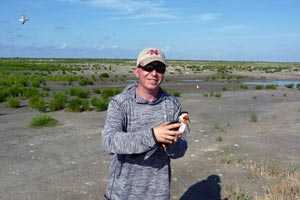 Aaron R. Pierce
Aaron R. Pierce
Nicholls State University,
Department of Biological Sciences
An aspect of my research that I’m excited about:
I am excited about the foraging information we are getting when we use GPS data loggers to track Royal Terns and Black Skimmers. We are learning that these species travel much further away from breeding colonies than we previously thought. This means that the birds depend on a greater variety of coastal habitats than we had considered.
Why my research is important:
I study wetland systems and the birds that depend on wetland resources. Birds are useful indicators of wetland health because of their top position in wetland food webs. Birds are sensitive to pollution and environmental changes, and birds are directly affected by coastal restoration projects and disturbances such as oil spills and hurricanes. By studying birds, I seek to understand how wetland systems work and how humans affect them. My research will help improve the way we conserve and manage wetlands so they can continue providing important benefits.
 Liz Skilton
Liz Skilton
University of Louisiana at Lafayette, Department of History, Geography & Philosophy
An aspect of my research that I’m excited about:
I am fascinated by the frequently-asked, but never-answered question of why we name hurricanes and what impact these names have on us. In my view, the hurricane naming system represents more than just linguistic flair; it changes the way we think about every disaster.
Why my research is important:
I study the history of disaster, particularly in Louisiana. I focus on the way coastal populations have reacted and adapted to disasters, such as hurricanes, flooding, and erosion. By examining our responses to events in the past, I shed light on ways we can better prepare for future disasters.
My current book project, Tempest: Hurricanes & American Culture, reviews the history of the gendered naming process of storms (like Hurricanes Audrey and Katrina) and how these names affect our perception of hurricanes. Because names matter, our labeling system for hurricanes has unintended consequences for everything from evacuation procedures to financial assistance post-hurricane. The way we name hurricanes even impacts how we respond to other disasters that are not named, such as floods, tornados, and blizzards. Knowing this, we can adjust the way we prepare for and react to disasters.
My other work builds on these themes by looking at how other disasters have impacted Louisiana. One of my grant projects focuses on the impact of the Lafayette Grand 16 Theater Shooting Incident. Another of my research projects examines the history of coastal erosion in the Chenier Plain of Louisiana. In both of these projects, I review how Louisiana communities experience and recover from disaster.
From hurricanes to coastal erosion, my research on the history of Louisiana disasters reveals much about how we understand and react to crises. When we dig deeper into the way we label and think about disasters, it helps us better respond to the next one.
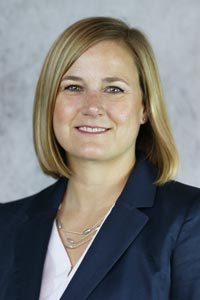 Beth Stauffer
Beth Stauffer
University of Louisiana at Lafayette,
Department of Biology
An aspect of my research that I’m excited about:
I am excited to better understand the processes and interactions structuring coastal phytoplankton communities, how those are likely to change given climate and land use change, and what those different communities mean for food webs.
Why my research is important:
My research focuses on the single-celled plant-like organisms – phytoplankton – that form the base of the food web in ocean and coastal ecosystems. I try to better understand how communities of these important producers are structured and how and why they sometimes grow out of balance with the rest of the ecosystem. These dynamics have important implications for food webs, the fate of carbon and energy in marine ecosystems, and overall coastal ecosystem health. My research is important both because it seeks to better understand the base of the food web and due to issues surrounding imbalances of these organisms, for example harmful algal blooms, eutrophication and hypoxia, and still poorly understood effects of climate and land use change on phytoplankton communities.
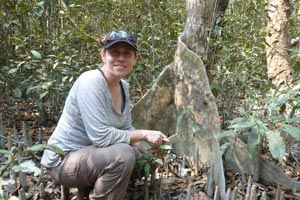
Carol A. Wilson
Louisiana State University,
Department of Geology & Geophysics
An aspect of my research that I’m excited about:
I love working in deltas and wetlands because they are so dynamic; one could argue that in no other place on Earth can you observe a truer marriage between biology, geology, and hydrology.
Why my research is important:
Wetland loss is a critical problem in the Mississippi delta, yet natural and anthropogenic (man-made) processes related to this loss are found in many delta and coastal areas worldwide. My research centers on quantifying ecophysical processes that shape wetland landscapes: I study how biology, geology, and water interact to create and modify a delta and wetland surface. My investigations focus on where and under what physical conditions organic and inorganic sediments are deposited, how these sediments are preserved, and how perturbations (which may be physical, biologic, or anthropogenic) affect these processes. I have worked in various wetland environments such as the saltmarshes of Louisiana, South Carolina, Georgia, and Massachusetts, and more recently in the mangrove forests of Bangladesh. In Bangladesh, our team is studying how land use changes from human activity (e.g., the embankment of tidal islands, deforestation) impacts the distribution of water and sediment and the susceptibility of embankment failure during storm events. This research not only helps identify how reclaimed land impacts the natural dynamics of the densely-populated Ganges Brahmaputra delta and resilience to storm surges, but also provides information on changes of the physical environment for social scientists researching migration patterns.
